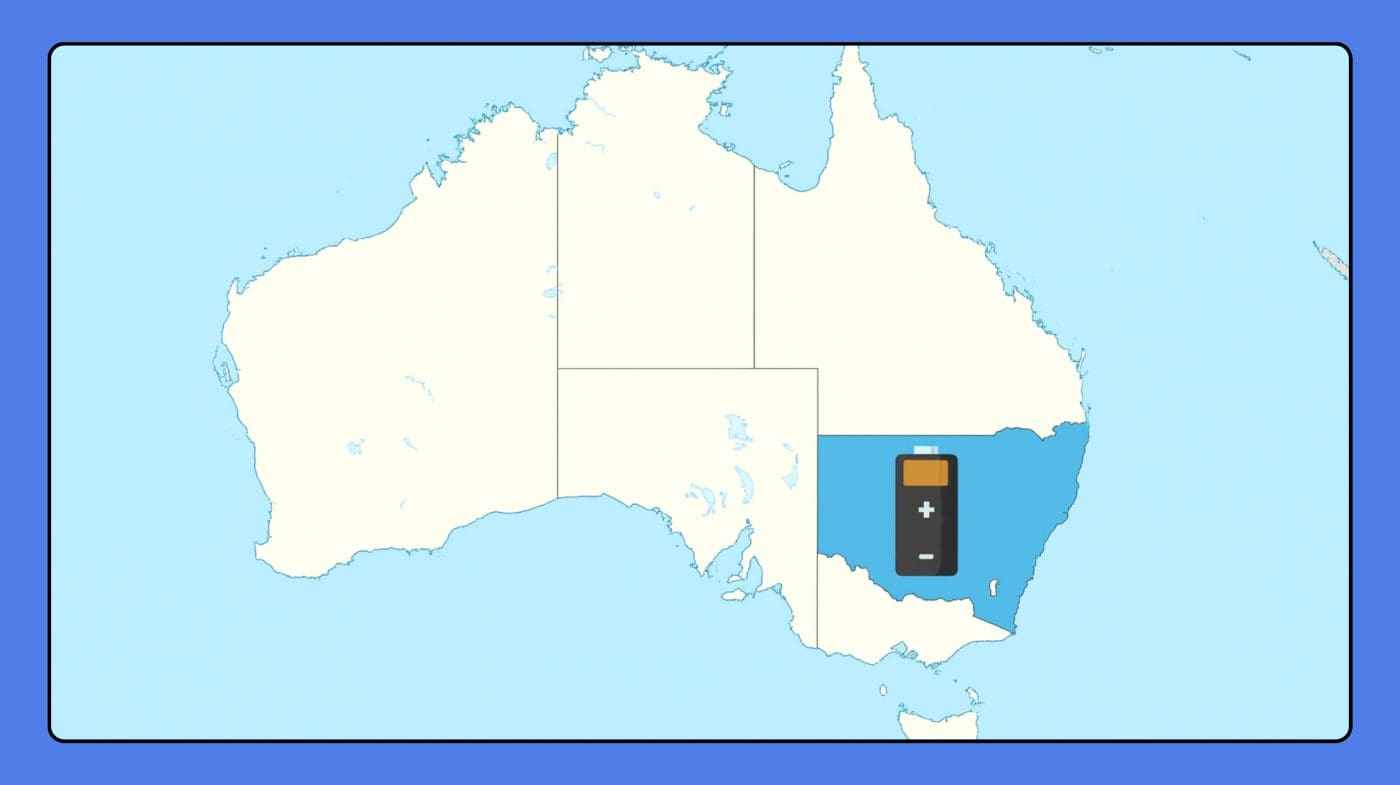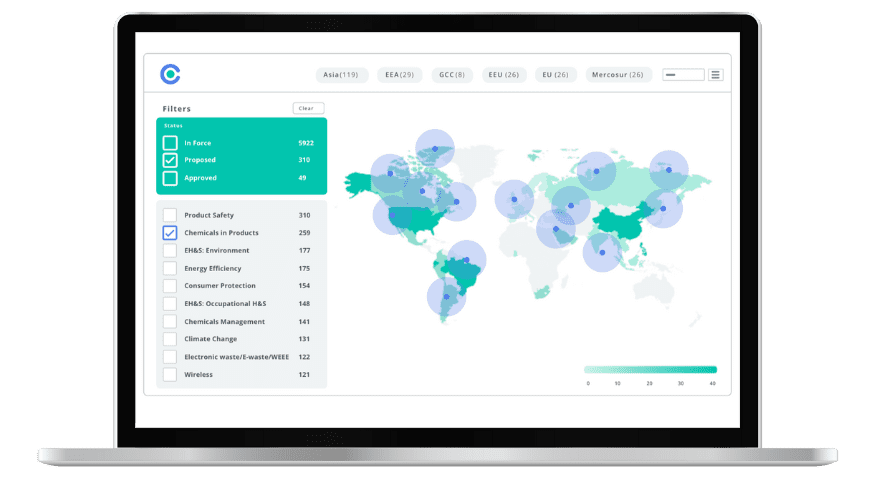
Understanding New South Wales Product Lifecycle Responsibility Act 2025: Mandatory Extended Producer Responsibility and its Reach Beyond NSW

This blog was originally posted on 25th September, 2025 and updated on 18th September, 2025. Further regulatory developments may have occurred after publication. To keep up-to-date with the latest compliance news, sign up to our newsletter.
AUTHORED BY ANDREW O’NEILL, REGULATORY COMPLIANCE SPECIALIST, COMPLIANCE & RISKS
New South Wales has enacted the Product Lifecycle Responsibility Act 2025, a landmark law introducing mandatory Extended Producer Responsibility (EPR) for products, with batteries as the initial focus. Passed in March 2025, this nation-first legislation requires battery manufacturers and suppliers to take responsibility for the entire lifecycle of their products, from design and production through to end-of-life recycling and safe disposal. The Act’s objective is to reduce environmental and safety risks (such as battery fires and toxic landfill leachate) by making brand owners accountable for managing battery waste in a circular economy model.
Importantly, the law has extraterritorial implications, it will affect companies outside NSW that sell or supply battery products into NSW, including interstate and online businesses. This blog post examines the Act’s key battery-specific provisions and what they mean for battery suppliers, manufacturers, and stakeholders operating beyond NSW’s borders. It also offers strategic guidance for out-of-state companies to prepare for compliance with the new requirements.
What Qualifies as a Regulated Battery Product?
Under the Act, a “regulated product” is any product (or component of a product) designated by future regulations. The NSW Government has announced that batteries will be the first regulated product category, given the surge in lithium-ion battery fires and incidents across Australia. This means virtually all types of batteries and battery-containing products are expected to fall under the mandatory scheme. The scope will include standalone batteries (e.g. loose lithium-ion cells, lead-acid batteries) as well as embedded batteries in everyday devices. Even batteries in e-mobility devices (such as e-bikes and e-scooters) and consumer electronics (power tools, vapes, toys, etc.) are slated for regulation, due to the fire and safety risks they pose.
In practice, if a product contains a battery, it will likely be treated as a regulated battery product under this law. For example, an electric toothbrush or cordless vacuum with an internal battery would be covered, not just standalone battery packs. This broad definition ensures that producers cannot evade responsibility by embedding batteries inside products, the entire product can be brought into the scheme.
Future regulations will detail exactly which battery categories or sizes are included, but companies should anticipate a wide-ranging coverage of battery types, focusing initially on those most linked to safety incidents (loose batteries and e-micromobility devices) and expanding to others over time.
Brand Owners and Stewardship Organisations: Who is Responsible?
The Act squarely places obligations on the “brand owner” of a regulated battery product. A brand owner is defined as the person or company who owns the name or brand under which the product is sold in NSW. This definition is broad; it can include manufacturers, importers, or retailers, and it applies whether or not the brand is based in NSW (even if a trademark is registered elsewhere). In other words, if your company’s branded batteries or battery-powered products are supplied in NSW, your company is the liable brand owner under this law, regardless of where your business is located. Product suppliers from other Australian states or overseas are not exempt, selling into NSW brings you into the scope of the Act.
- To fulfill their EPR obligations, brand owners will often work with or through Product Stewardship Organisations (PSOs). A PSO is an entity (often an industry-led non-profit) responsible for administering a product stewardship scheme on behalf of multiple companies. Under the Act, the NSW EPA (as the regulator) can enter into stewardship administration agreements with approved PSOs. These agreements empower the PSO to run a battery stewardship program (for example, managing collection and recycling of batteries) and to collect fees from member brand owners to fund the scheme.
- In essence, brand owners have a choice: either join an approved stewardship scheme (and comply via that collective program) or manage an individual action plan for compliance (see below). Joining a PSO will likely be the practical route for most companies, especially those outside NSW, as it allows sharing the costs and infrastructure needed to meet the Act’s requirements. Notably, Australia already has a voluntary battery recycling scheme (B-cycle, accredited under the federal Recycling and Waste Reduction Act 2020), and it remains to be seen how this voluntary scheme will interact with NSW’s new mandatory framework.
- The NSW scheme is expected to be more comprehensive covering a broader scope of batteries (including embedded ones) and more effective due to its mandatory nature. Brand owners should watch for how existing programs like B-cycle might integrate or whether new PSOs will emerge specifically for NSW compliance.
- Both brand owners and PSOs have obligations under the Act. If a company chooses to fulfill its obligations via a PSO, that PSO must meet the terms of its agreement with the EPA, and failing to do so can result in penalties for the organisation. Meanwhile, the brand owner remains legally responsible to ensure compliance either way. In summary, brand owners of battery products supplied in NSW carry the primary responsibility under the Act, but they will likely discharge many duties through membership in a compliant stewardship scheme. Companies outside NSW should identify who the “brand owner” is for their products (for example, an overseas manufacturer might rely on its Australian importer or subsidiary to act as the brand owner) and make sure that entity is prepared to meet the NSW requirements.
Key Obligations for Battery Suppliers Under the Act
The Product Lifecycle Responsibility Act 2025 establishes a framework of product stewardship requirements that battery brand owners must adhere to. Once batteries are officially prescribed as a regulated product (via forthcoming regulations), the following obligations will apply:
Product Stewardship Requirements Across the Lifecycle
Brand owners must comply with any requirements imposed on the battery’s design, supply, use, and end-of-life management. This could include ensuring the use of recyclable materials, improving battery design for safer handling, providing clear labeling, and facilitating the collection, recycling, or safe disposal of used batteries. For example, regulations might require setting up take-back programs or drop-off points for used batteries, running public education campaigns on battery hazards, or enhancing battery packaging for safety. These specific stewardship measures will be detailed in the regulations, but companies should be ready to incorporate circular economy practices into their battery product life cycle (from design to disposal).
Pre-Supply Notification
Before a brand owner first supplies a regulated battery product in NSW, they must notify the EPA (and the relevant PSO, if one exists) of their intention to supply. In practical terms, this means registering the product/brand with the NSW authorities or scheme prior to selling or distributing it in NSW. This advance notice allows the regulator to know who is participating in the market and to ensure the brand owner is covered by a stewardship arrangement. Failure to give this notice is an offence under the Act.
Reporting Requirements
Brand owners will be required to submit regular reports on their battery products in NSW. At a minimum, an annual report to the EPA (and to the PSO, if applicable) is mandated within 3 months after the end of each financial year. These reports likely must detail quantities of batteries supplied, collected, recycled, etc., against any targets. In some cases, regulators may even request more frequent (e.g. quarterly) reporting to track progress. Keeping timely, accurate data on your products’ lifecycle performance will be critical.
Record-Keeping
Every brand owner (and every PSO) must maintain comprehensive records related to the battery stewardship scheme. Records should cover all relevant information for each financial year – for instance, the volume of batteries placed on the NSW market, collection and recycling data, arrangements made for disposal, and evidence of compliance with any specific requirements. These records must be kept for at least 6 years and be made available for inspection by authorised officers on request. Robust record-keeping systems (inventory tracking, contracts with recyclers, proof of consumer take-back, etc.) are thus a necessity to demonstrate compliance at audit.
Targets and Performance Requirements
The Act empowers the NSW Minister to set product stewardship targets for regulated products. For batteries, this might include targets like a minimum recycling rate, collection rate, or use of recycled content, expressed as a percentage. Such targets could be defined in the regulations or via a Ministerial order published in the Gazette. Brand owners must make genuine efforts to meet any targets set for batteries for example, ensuring that a certain percentage of sold batteries are recovered and recycled each year. Not meeting a target could be deemed a breach of the stewardship requirements (unless mitigated by approved action plans, see below). Companies should track their performance metrics closely and contribute to industry-wide efforts to hit these goals.
Our guide The Future Of Batteries: Compliance and Sustainability Under The New EU Regulation covers the changing battery regulatory landscape in 2025.
Action Plans (Compliance Plans)
If required by the regulations, battery brand owners (or the PSOs acting on their behalf) must develop and lodge an Action Plan with the regulator. An Action Plan is essentially a compliance plan outlining how the brand owner or scheme will fulfill all the stewardship obligations for the batteries. It should detail the strategies for collection, recycling, public education, safe handling, meeting targets, etc., and include any information prescribed by the regulations. The EPA must approve the Action Plan, and it may require revisions or impose conditions on it. Once approved, this becomes the “approved action plan” for that brand or scheme.
Supply Restriction (No Compliance, No Market Access)
Critically, if an Action Plan is mandated for batteries, a brand owner cannot supply those battery products in NSW unless an approved action plan is in effect and the supply is in accordance with that plan. This acts as a market access restriction – essentially, compliance is a precondition to selling batteries in NSW. If a company has not joined a compliant stewardship scheme or does not have its individual plan approved, it must cease supplying the battery product in NSW until it achieves compliance. This provision ensures that all sellers are playing by the same rules and non-compliant batteries are kept off the NSW market. Out-of-state suppliers should be acutely aware of this requirement: you cannot simply ship products to NSW without aligning with the scheme, or you risk having your products barred and legal penalties applied.
Financial Contributions
Participation in a stewardship scheme will also involve funding the scheme’s operations. Under EPA agreements, PSOs will collect fees from member brand owners to cover the costs of collection networks, recycling programs, audits, and administration. While the Act frames this in terms of agreements rather than a set fee schedule, companies should plan for contributing financially – whether via membership fees, per-unit levies, or other charges – to support the stewardship of batteries they place on the market. These costs are an integral part of compliance, enabling the collective infrastructure needed for battery lifecycle management.
The above obligations introduce a more stringent compliance burden on battery suppliers compared to the past voluntary regime. In summary, to sell batteries in NSW, brand owners must register and report their products, keep meticulous records, meet recycling/safety requirements and targets, and either participate in an approved stewardship scheme or have an individual action plan, all under regulatory oversight. Non-compliance with any of these duties is backed by enforcement (discussed below). Companies should treat these requirements as core business obligations for accessing the NSW market, similar to product safety or quality standards.
Extraterritorial Reach: Impact on Interstate and Overseas Companies
One of the most significant aspects of the NSW Product Lifecycle Responsibility Act is its extraterritorial reach. The law is explicitly designed to capture transactions and entities beyond the physical borders of NSW, so long as there is a supply of regulated products into NSW. In practice, this means:
Interstate Suppliers
If you are a battery manufacturer or distributor based in another Australian state (for example, Victoria or Queensland) and you ship or sell batteries into New South Wales (directly to retailers, businesses, or consumers), you are subject to the NSW Act. The obligations described above (registration, reporting, stewardship participation, etc.) will apply to you as the brand owner or supplier for NSW sales. The Act makes no distinction based on where your company is headquartered or operates – what matters is that your product is placed “into or within” NSW. Even if a contract of sale is executed outside NSW, supplying the product into NSW brings it under NSW jurisdiction.
Online and E-commerce Sales
The Act also covers products sold online and delivered to NSW addresses. For example, an overseas or interstate company selling battery products via an e-commerce platform to Sydney customers is considered a supplier into NSW. Such companies will need to ensure compliance just as a local NSW supplier would. This closes a potential loophole where online sellers might have previously bypassed state-level environmental regulations.
Overseas Manufacturers
- If you are an overseas battery manufacturer with no local subsidiary, the law can still affect you indirectly. Typically, the Australian importer or distributor of your batteries will be the “brand owner” in NSW and bear the compliance duties. However, you may need to support your local partners in meeting design or supply chain requirements (for instance, providing data for reporting or adapting product design to meet stewardship standards). Moreover, if you directly sell into NSW (e.g. via online direct sales), you could be held accountable. In effect, NSW can enforce against entities “whether or not the person is outside the State”. Enforcement across borders may require cooperation with other jurisdictions, but any company ignoring the law could find its products restricted from the NSW market.
- The extraterritorial scope of this Act signals to industry that geography is not a shield from responsibility. Environmental impacts do not respect state lines; a battery ending up in a NSW landfill or recycling facility engages NSW’s interest, no matter where it was produced or sold from. For companies in other Australian states, this creates a need to incorporate NSW compliance into their operations. You might be used to different rules (or no such rules yet) in your home state, but to continue business with NSW clients or retailers, you must now meet NSW’s EPR requirements.
- It’s also worth noting that other states are closely watching NSW’s move. NSW is the first state in Australia to mandate a battery stewardship scheme, but it likely will not be the last. Victoria, South Australia, and others have shown interest in battery recycling and could replicate this model in coming years. Additionally, there are calls for a national approach to battery EPR to avoid a patchwork of state regulations. Therefore, out-of-state companies should view NSW’s law as possibly the first step in a broader shift. Proactively complying in NSW will position you ahead of the curve if (or when) similar rules emerge elsewhere. In the meantime, treat NSW as a priority market for compliance: ensure any battery product entering NSW, whether through your own sales channels or third-party distributors, is covered by a stewardship arrangement. If you rely on distributors in NSW, work closely with them to clarify who will handle registration and compliance tasks but remember, the law ultimately targets the brand owner name on the product, which could be you.
Conclusion
The New South Wales Product Lifecycle Responsibility Act 2025 heralds a new era of accountability for battery suppliers and manufacturers. It extends the concept of “producer responsibility” to make those who profit from batteries also responsible for managing their safe lifecycle end-to-end. For industry professionals, especially those operating outside NSW, the key takeaway is clear: if you want to sell battery products in NSW, you must play by NSW’s rules. Geography offers no exemption; the law’s reach across borders and online marketplaces ensures a level playing field where every brand owner must contribute to stewardship.
Although the Act is now law, not all its provisions are yet in force. Many parts require regulations to be made before they become operational for particular regulated products (batteries in particular). The Act, in its current form, has a clause noting that it will commence on a date to be proclaimed. This means the government needs to declare when specific obligations under the Act take effect. As of the latest information, the NSW EPA is targeting battery-specific regulation (i.e. when battery products will become “regulated” under the scheme) to commence in Q2 2026.
In sum, the mandatory battery EPR in NSW is a pioneering move that industry stakeholders cannot afford to overlook. Companies outside NSW should treat compliance not as a local quirk, but as part of their broader corporate responsibility and risk management strategy. The message is simple: be prepared, get compliant, and embrace the change the era of extended producer responsibility for batteries has arrived in Australia, starting with NSW.
Want to stay ahead of these evolving regulatory developments? See how our Batteries regulatory content can help you!
Stay Ahead Of Regulatory Changes in Batteries
Want to stay ahead of regulatory developments in batteries?
Accelerate your ability to achieve, maintain & expand market access for all products in global markets with C2P – your key to unlocking market access, trusted by more than 300 of the world’s leading brands.
C2P is an enterprise SaaS platform providing everything you need in one place to achieve your business objectives by proving compliance in over 195 countries.
C2P is purpose-built to be tailored to your specific needs with comprehensive capabilities that enable enterprise-wide management of regulations, standards, requirements and evidence.
Add-on packages help accelerate market access through use-case-specific solutions, global regulatory content, a global team of subject matter experts and professional services.
- Accelerate time-to-market for products
- Reduce non-compliance risks that impact your ability to meet business goals and cause reputational damage
- Enable business continuity by digitizing your compliance process and building corporate memory
- Improve efficiency and enable your team to focus on business critical initiatives rather than manual tasks
- Save time with access to Compliance & Risks’ extensive Knowledge Partner network

EU Battery Regulation: Key Compliance & Sustainability Requirements for 2025 & Beyond
Join us for an in-depth webinar as we explore the key obligations under the new EU Battery Regulation (EUBR).


